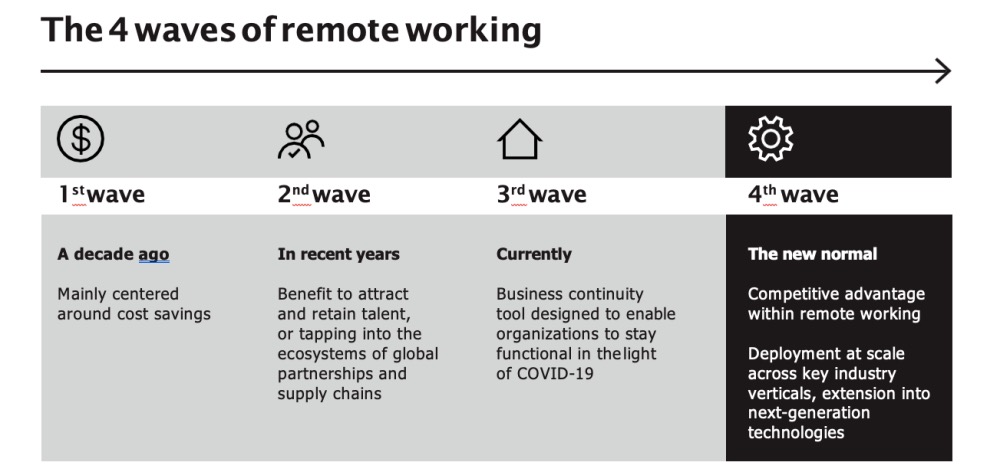It’s a constant concern for business leaders around the globe. Every year, think-tanks, businesses (including Verizon), academics and analysts give their view on the technology trends that they believe will most impact the future workplace—and how those technologies are shaping business technology investment. As the world gets ready to return to business, here are some key considerations for CIOs to ponder about.
By Sowmyanarayan Sampath, Verizon, President – Global Enterprise
 Over the years, the pressures driving toward remote working have been building, but no one could have predicted the seismic shift caused by COVID-19. Entire functions of many global organizations are now working remotely, and this looks set to permanently alter the way people think about the world of work.
Over the years, the pressures driving toward remote working have been building, but no one could have predicted the seismic shift caused by COVID-19. Entire functions of many global organizations are now working remotely, and this looks set to permanently alter the way people think about the world of work.
Remote working is no longer a benefit, luxury or convenience. It’s also more than a current make-do for organizations looking to conduct business as usual. We argue that senior leaders will have to leverage this inflection point to drive sustainable competitive advantage for their organizations in the new normal.
We are creating a series of articles that will examine how business leaders need to think about enabling the workplace of the future, with remote working fully integrated into business practice. In this first article, we are focusing on the technology building blocks that CIOs need to consider while taking into account the underlying emerging set of new technologies.
The COVID-19 effect
Even before the coronavirus hit, remote working had been steadily increasing in many countries around the globe. For example, the St. Louis Federal Reserve Bank 1 found that over the last 30 years, remote working in the U.S. has grown 7% yearly. Despite that growth, only 7% of U.S. civilians currently have access to a “flexible workplace” benefit, according to the U.S. Bureau of Labor Statistics.
Many organizations, therefore, have largely stayed true to the idea of the office workplace and remote working was an option 2 —that is, until COVID-19 hit. One reason for this could be that many established businesses have foundations that were built in the last century, and the corporate world is still primarily defined by the baby boomers — a group that entered the workforce before mobile phones, personal computers and the internet even existed. For them, the office is where work is done, and the very concept of remote working may raise concerns over productivity and motivation. Which is why many organizations have not enabled remote working as part of their business as usual before now. Those organizations that were still largely built around an office-based model are the ones that have had to scramble the hardest in recent weeks in the drive to set up remote working capabilities.

In our view, there are four waves of remote working, and right now, we’re in the middle of the COVID-19-induced third wave. The COVID-19 crisis is hastening organizations ambitions to embrace remote working as the new normal, as the world makes a return to business.
CIOs around the globe need to think about how to make this happen, especially as the world makes a return to business.
What’s interesting is that, over recent years, we’ve already seen “traditional” ways of working being pressured from various directions, including the impact of the sharing economy on lifestyle, the gradual decline in commute efficiency, the fight for millennial talent and the impact of the climate crisis on air travel. This is perhaps why many jobs were already starting
to be enabled remotely, from contact centers to customer service, computer programming to sales, data entry to medical billing, coding to design.
What is becoming clear is that the post-COVID-19 new normal will be different. Boston Consulting Group’s 3 view is that “comfort with remote work will reshape our future workplace,” where flexible work arrangements will increasingly be the norm. In the post-COVID-19 fourth wave of remote working, organizations wishing to drive sustainable competitive advantage will have to resolve a set of challenges across both technologies and people, and piece together talent attraction and retention, employee engagement and partner engagement effectiveness in a cohesive manner. Underlying this wave will be the emerging deployment across key industries of a set of new technologies now taking shape, such as artificial intelligence (AI), machine learning (ML), and spatial sensing and mapping.
For example, remote workers will need access to experts; call center operators will need an environment where security and data privacy issues are well addressed; and teachers will need a way to monitor tests and exams. It’s critical to start with the user’s needs and create a user experience that threads back through the supporting technologies to create a user-friendly and highly functional working environment.
Return to business: The challenge for CIOs
The unique set of challenges presented by a remote workforce requires all senior leaders of an organization—CIOs, CHROs, CISOs—to work together to resolve them. The CIO needs to be a proactive participant in leading and driving change, describing the competitive advantage and clearly demonstrating the link between the technology agenda and the employee value proposition. Opening up the possibility of remote working to more employees demonstrates that it can work (and in days rather than months), so it can be a part of the new operational plan. But that means throwing away the old plan. They may have been working toward a PC refresh, a global software deployment or a new software-defined wide area network.
Are those still the right priorities for the business?
Of course, it’s not that CIOs don’t plan for unprecedented events. It’s that most business continuity plans contemplate regional pandemics, and focus on how other regions of the globe can pick up the workplace slack. The global nature of the COVID-19 pandemic is unprecedented and has caught many CIOs unaware.
Within this new wave, the CIO’s role in managing the table-stake agenda from the previous three waves remains the same.
From the broadest goal of on-the-ground operations (such as ensuring that technological systems and procedures are aligned with business goals) to planning ahead for the future (like understanding digital technologies and how to cost-effectively utilize them), the CIO still plays an integral role. But now an additional focus needs to be put on the forward-looking “next wave” of technical building, beyond the table-stakes priorities. And early preparation is key.
Challenges and resolutions
As we get ready to return to business we should consider the challenges of remote working. When most people talk about remote working today, they are really talking about working from home. And of course, that is what many people are currently doing. What’s interesting is that, even before we entered the pandemic situation, Gartner research suggested that “By 2030, the demand for remote work will increase by 30% due to Generation Z fully entering the workforce.”4 However, the model needs to be flexible—the ability to “work from wherever,” rather than just home, is key. The challenge for CIOs is that most current workplace constructs cannot be fully scaled to support a flexible remote-working model.
We have already mentioned that buy-in from senior leadership is critical to ensuring that an effective remote-working model is created.
For the CIO specifically, six factors are required for an employee to be able to effectively work remotely.
- A scalable network enabled by automation, such as software-defined networking (SDN) and virtualized network services (VNS), that can flex to support new usage patterns with work shifting outside of offices and enable application availability
- Cloud-ready applications for collaboration, core operations and
- Strong and secure mobile connectivity to access those applications, as well as the corporate WAN (for those that are not cloud-enabled).
- End-to-end monitoring of network performance to maintain control, usability and
- Zero-trust security implementation that strengthens the protection of sensitive information outside of physical
- A resilient end-user support model and supply chain that can deal with spikes in teleworker demand, both in terms of calls for help and the need for laptops, tablets or other mobile
For many organizations, the COVID-19 pandemic has highlighted the gaps in their current model that prevent scalability.
About the Author
Sampath Sowmyanarayan is President, Global Enterprise for Verizon Business Group.
REFERENCES
- https://www.stlouisfed.org/publications/regional-economist/third-quarter-2019/working-home-more-americans-telecommuting
- https://www.pewresearch.org/fact-tank/2020/03/20/before-the-coronavirus-telework-was-an-optional-benefit-mostly-for-the-affluent-few/
- https://www.linkedin.com/pulse/covid-19-future-work-diana-dosik/
- “With Coronavirus in Mind, Is Your Organization Ready for Remote Work?,” Smarter with Gartner, March https://www.gartner.com/smarterwithgartner/with-coronavirus-in-mind-are-you-ready-for-remote-work/
- https://op.europa.eu/webpub/eca/special-reports/broadband-12-2018/en/
- https://enterprise.verizon.com/resources/reports/dbir/









